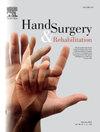Ultrasound-guided trigger finger release with a minimally invasive knife: A retrospective analysis of 297 releases
IF 1
4区 医学
Q4 ORTHOPEDICS
引用次数: 0
Abstract
Trigger finger, or stenosing tenovaginitis, is a common condition characterized by impaired flexor tendon sliding due to thickening of the A1 pulley. While open surgical release remains the gold standard for the treatment of persistent trigger finger, there is increasing interest in minimally invasive ultrasound-guided techniques to improve precision and outcomes.
The purpose of this study is to evaluate the outcomes, safety, and complications associated with ultrasound-guided trigger finger release using a minimally invasive surgical knife.
We performed a retrospective analysis of 297 trigger finger releases performed on 238 patients between April 2021 and December 2023. All procedures were performed on the long fingers, excluding the thumb, using ultrasound guidance under WALANT or regional anesthesia. Patients were evaluated at 6 weeks and 3 months postoperatively for symptom resolution, complications, and functional recovery.
The procedure achieved a 100% success rate for complete release of the A1 pulley with no major complications or iatrogenic damage such as tendon or neurovascular injury. Minor complications, such as temporary postoperative loss of motion or localized pain, occurred in 33 cases (11.1%) and all resolved with conservative management by the three-month follow-up. Importantly, only one procedure required conversion to open surgery due to intraoperative uncertainty, where full release was confirmed.
Ultrasound-guided minimally invasive trigger finger release is a safe and effective technique. It provides precise release with a low risk of complications or iatrogenic damage. As ultrasound technology advances and availability increases, this technique has the potential to become a reliable and patient-friendly alternative to classic open methods.
超声引导下微创刀触发指释放:297例释放的回顾性分析。
扳机指,或狭窄性腱鞘炎,是一种常见的情况,其特征是由于A1滑轮增厚导致屈肌腱滑动受损。虽然开放性手术释放仍然是治疗持续性扳机指的金标准,但人们对微创超声引导技术的兴趣越来越大,以提高精度和结果。本研究的目的是评估超声引导下微创手术刀触发指松解术的疗效、安全性和并发症。我们对238名患者在2021年4月至2023年12月期间进行的297次扳机指释放进行了回顾性分析。在WALANT或区域麻醉下,在超声引导下,所有手术均在长手指(大拇指除外)上进行。在术后6周和3个月对患者进行症状缓解、并发症和功能恢复的评估。该手术实现了100%的成功率,完全释放A1滑轮,无重大并发症或医源性损伤,如肌腱或神经血管损伤。33例(11.1%)患者出现术后暂时性运动能力丧失或局部疼痛等轻微并发症,3个月随访时均通过保守治疗解决。重要的是,由于术中不确定性,只有一个手术需要转换为开放手术,并确认完全释放。超声引导下微创触发指松解术是一种安全有效的技术。它提供精确的释放,并发症或医源性损伤的风险低。随着超声技术的进步和可用性的增加,这项技术有可能成为传统开放方法的可靠和患者友好的替代方法。
本文章由计算机程序翻译,如有差异,请以英文原文为准。
求助全文
约1分钟内获得全文
求助全文
来源期刊

Hand Surgery & Rehabilitation
Medicine-Surgery
CiteScore
1.70
自引率
27.30%
发文量
0
审稿时长
49 days
期刊介绍:
As the official publication of the French, Belgian and Swiss Societies for Surgery of the Hand, as well as of the French Society of Rehabilitation of the Hand & Upper Limb, ''Hand Surgery and Rehabilitation'' - formerly named "Chirurgie de la Main" - publishes original articles, literature reviews, technical notes, and clinical cases. It is indexed in the main international databases (including Medline). Initially a platform for French-speaking hand surgeons, the journal will now publish its articles in English to disseminate its author''s scientific findings more widely. The journal also includes a biannual supplement in French, the monograph of the French Society for Surgery of the Hand, where comprehensive reviews in the fields of hand, peripheral nerve and upper limb surgery are presented.
Organe officiel de la Société française de chirurgie de la main, de la Société française de Rééducation de la main (SFRM-GEMMSOR), de la Société suisse de chirurgie de la main et du Belgian Hand Group, indexée dans les grandes bases de données internationales (Medline, Embase, Pascal, Scopus), Hand Surgery and Rehabilitation - anciennement titrée Chirurgie de la main - publie des articles originaux, des revues de la littérature, des notes techniques, des cas clinique. Initialement plateforme d''expression francophone de la spécialité, la revue s''oriente désormais vers l''anglais pour devenir une référence scientifique et de formation de la spécialité en France et en Europe. Avec 6 publications en anglais par an, la revue comprend également un supplément biannuel, la monographie du GEM, où sont présentées en français, des mises au point complètes dans les domaines de la chirurgie de la main, des nerfs périphériques et du membre supérieur.
 求助内容:
求助内容: 应助结果提醒方式:
应助结果提醒方式:


